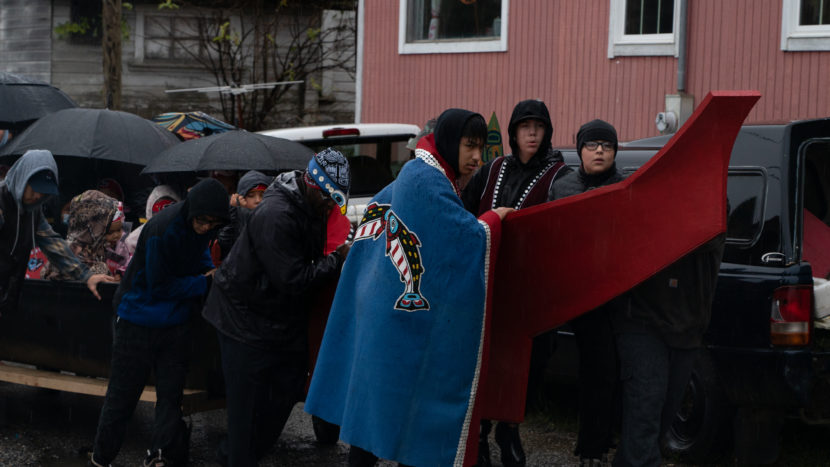
Angoon High School students surrounded Wayne Price as he helped them guide a canoe down Angoon’s roads to the waterfront.
This dugout canoe, or yaakw, is special. It’s the first one built in Angoon in 140 years — that is, since Angoon was attacked and destroyed by U.S. military forces. Students who helped carve the canoe say the project helped them see their own resilience.
In 1882, the U.S. Navy bombarded Angoon, burned their clan houses and food stores and destroyed their canoes — except for one that was away from the village.
The people of Angoon — or Xutsnoowú Ḵwáan — were left for the winter with only one boat to fish and no shelter. It’s not known how many died as a result of this. But many of the families of those who survived are still in Angoon today.
The U.S. Navy has never apologized.
The bombardment happened along the waterfront where Price and the students walked, their hands steadying the boat as they wheeled it along.
Shgein Kyle Johnson, who helped carve the yaakw with Price, led songs for the procession. He and five other students fasted for a day as they steamed the canoe open last month. That’s the process of painstakingly adding hot rocks to the boat and using trapped steam to expand the inside. It can be a make-or-break moment for canoes.
“I am very, very proud of my teammates that helped me with the steaming process, and as a community just proud to finally have this new beginning,” Johnson said.
This yaakw is Shaagaa Eesh Anthony Johnson’s second. He was in Hoonah when Price worked with students there to carve a dugout.
Anthony said it feels different, being six years older this time.
“I was just putting wood on the fire then,” he said. “Now I’m one of the steamers taking out the rocks and stuff like that, and working on the canoe with Wayne.”
Price says the yaakw is seaworthy.
“All of the dugouts that I’ve built are ready and able to meet each other on the water, and what a day that will be,” he said.
Kyle’s mother, Kookeesh Tlaa Chenara Johnson, is a Lingít language teacher in the Chatham School District. She coordinated the youth who assisted in the yaakw carving. She says this history shows the resilience of the Xutsnoowú Ḵwáan.
“We’re still here, and our community is thriving,” she said. “And our students and our children are eager to learn and eager to carry on that part of our culture.”
Kyle says he’s hoping for more opportunities like this one.
“It’s a lot easier to learn about our culture and our traditional ways when it’s hands-on,” he said.
In the spring, the yaakw will be given a name and launched on the water for the first time — with Anthony, Kyle and several of their classmates aboard.
KTOOis our partner public media station in Juneau. Alaska Public Media collaborates with partners statewide to cover Alaska news.




